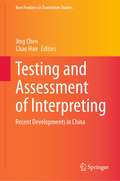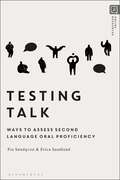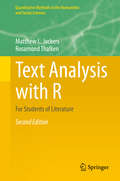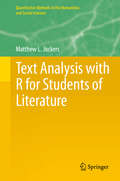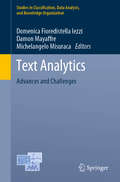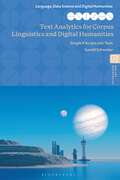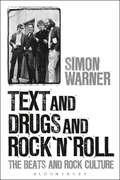- Table View
- List View
Testing and Assessment of Interpreting: Recent Developments in China (New Frontiers in Translation Studies)
by Jing Chen Chao HanThis book highlights reliable, valid and practical testing and assessment of interpreting, presenting important developments in China, where testing and assessment have long been a major concern for interpreting educators and researchers, but have remained largely under-reported. The book not only offers theoretical insights into potential issues and problems undermining interpreting assessment, but also describes useful measurement models to address such concerns. Showcasing the latest Chinese research to create rubrics-referenced rating scales, enhance formative assessment practice, and explore (semi-)automated assessment, the book is a valuable resource for educators, trainers and researchers, enabling to gain a better understanding of interpreting testing and assessment as both a worthwhile endeavor and a promising research area.
Testing English: Formative and Summative Approaches to English Assessment
by Bethan MarshallThis book considers why summative assessment in English is difficult and explores viewing it as an arts subject rather than one which is quantifiable and assessable objectively.
Testing Lecture Comprehension Through Listening-to-summarize Cloze Tasks: The Trio of Task Demands, Cognitive Processes and Language Competence
by Haiping WangThis book explores the effectiveness of listen-to-summarize tasks as a tool to assess lecture comprehension ability. It especially focuses on listen-to-summarize tasks that represent listeners’ meaning building and the discourse construction of the lecture for listening assessment purposes. It discusses in depth the nature of lecture comprehension and introduces the approaches to assessing it. It also presents teachers’ and students’ perceptions of listen-to-summarize task demands and their respective implications. By observing interactions between test-takers’ cognitive processes and the task itself, the book explores the effectiveness of these tasks. It also examines the discrepancy in cognitive processes between different language competence levels in detail, shedding light upon current research on lecture comprehension assessment and offering insights into listening comprehension instruction.
Testing New Opinions and Courting New Impressions: New Perspectives on Walter Pater (Among the Victorians and Modernists)
by Anne-Florence Gillard-Estrada Martine Lambert-Charbonnier Charlotte RibeyrolReflecting Walter Pater’s diverse engagements with literature, the visual arts, history, and philosophy, this collection of essays explores new interdisciplinary perspectives engaging readers and scholars alike to revisit methodologies, intertextualities, metaphysical positions, and stylistic features in the works of the Victorian essayist. A revised contextual portrait of Pater in Victorian culture questions representations of the detached aesthete. Current editorial and biographical projects show Pater as fully responsive to the emergence of modern consumer culture and the changes in readership in Britain and the United States. New critical views of rarely studied texts enhance the image of Pater as a cosmopolitan aesthete dialoguing with contemporary culture. Conceptual analysis of his texts brings new light to the aesthetic paradox embodied by Pater, between artistic detachment and immersion in the Heraclitean flux of life. Finally, aestheticism is redefined as proposing new artistic and linguistic synthesis by merging art forms and embracing interart poetics.
Testing New Opinions and Courting New Impressions: New Perspectives on Walter Pater (Among the Victorians and Modernists)
by Anne-Florence Gillard-Estrada Martine Lambert-Charbonnier Charlotte RibeyrolReflecting Walter Pater’s diverse engagements with literature, the visual arts, history, and philosophy, this collection of essays explores new interdisciplinary perspectives engaging readers and scholars alike to revisit methodologies, intertextualities, metaphysical positions, and stylistic features in the works of the Victorian essayist. A revised contextual portrait of Pater in Victorian culture questions representations of the detached aesthete. Current editorial and biographical projects show Pater as fully responsive to the emergence of modern consumer culture and the changes in readership in Britain and the United States. New critical views of rarely studied texts enhance the image of Pater as a cosmopolitan aesthete dialoguing with contemporary culture. Conceptual analysis of his texts brings new light to the aesthetic paradox embodied by Pater, between artistic detachment and immersion in the Heraclitean flux of life. Finally, aestheticism is redefined as proposing new artistic and linguistic synthesis by merging art forms and embracing interart poetics.
The Testing of Barbara Pym: London, the Wilderness Years, and the Rewards of Age
by Emily StockardThe Testing of Barbara Pym, a companion volume to The Making of Barbara Pym (Palgrave Macmillan, 2021), completes a comprehensive analysis of Pym’s novels and her life, focusing on her complex view of the necessity of change at both the individual and cultural levels. Newly published archival material supports this treatment of Pym’s vision of a changing world – a vision premised upon the principle of continuity, a linking together of past, present, and future. In her novels published from 1955-1980, beginning with Britain’s emergence from post-war austerity, Pym portrays, in an optimistic fashion, several changing aspects of British culture: expansion of the suburbs, acceptance of homosexual men, erosion of the class system, inclusivity in the Anglican Church. But with these changes, new strains emerge as well; the principle of continuity undergoes radical testing and is then emphatically reasserted. Likewise, despite upheavals to established patterns in her life, chiefly the inability to publish her work, Pym persisted in cultivating such elements of continuity as she could, an effort rewarded, while she was in rural retirement, by a return to the publishing world. Thus, in both Pym’s novels and her life, continuity survives the duress of testing circumstances.
Testing Second Language Speaking
by Glenn FulcherThe testing and assessment of second language learners is an essential part of the language learning process. Glenn Fulcher's Testing Second Language Speaking is a state-of-the-art volume that considers the assessment of speaking from historical, theoretical and practical perspectives.The book offers the first systematic, comprehensive and up-to-date treatment of the testing of second language speaking. Written in a clear and accessible manner, it covers: Explanations of the process of test design Costing test design projects How to put the test into practice Evaluation of speaking tests Task types for testing speaking Testing learners with disabilities It also contains a wealth of examples, including task types that are commonly used in speaking tests, approaches to researching speaking tests and specific methodologies that teachers, students and test developers may use in their own projects. Successfully integrating practice and theory, this book demystifies the process of testing speaking and provides a thorough treatment of the key ethical and technical issues in speaking evaluation.
Testing Second Language Speaking
by Glenn FulcherThe testing and assessment of second language learners is an essential part of the language learning process. Glenn Fulcher's Testing Second Language Speaking is a state-of-the-art volume that considers the assessment of speaking from historical, theoretical and practical perspectives.The book offers the first systematic, comprehensive and up-to-date treatment of the testing of second language speaking. Written in a clear and accessible manner, it covers: Explanations of the process of test design Costing test design projects How to put the test into practice Evaluation of speaking tests Task types for testing speaking Testing learners with disabilities It also contains a wealth of examples, including task types that are commonly used in speaking tests, approaches to researching speaking tests and specific methodologies that teachers, students and test developers may use in their own projects. Successfully integrating practice and theory, this book demystifies the process of testing speaking and provides a thorough treatment of the key ethical and technical issues in speaking evaluation.
Testing Talk: Ways to Assess Second Language Oral Proficiency
by Dr Pia Sundqvist Dr Erica SandlundOral assessments are of vital importance to second language learners, but how can teachers and examiners best test L2 learner talk and interaction? Bringing together theory and research within the field of L2 oral proficiency, with the concept of L2 encompassing any language learned later than the early childhood years, this book provides a state-of-the art overview of what is at stake for L2 learners and examiners, and advice on how to approach testing and assessment. Using data and findings from empirical research to illustrate and discuss key topics, Testing Talk takes the reader step-by-step through the major concepts and issues in the oral assessment of second languages, with a main focus on L2 English. Investigating and explaining the most important educational and interactional issues facing both examiners and test-takers, such as the factors which come into play during speaking tests, the differences between common test formats, and the challenge of ensuring equity in assessment, this book offers research-based advice on ways to design test tasks and in-depth insights into the assessment of L2 speaking. Featuring a glossary of key terms and concepts, discussion questions and further reading for each chapter, and a comprehensive companion website hosting a wealth of additional materials, including authentic test recordings and assessment tasks to be used by researchers and practitioners alike, this is the only book needed in order to understand, design, and assess interactive oral L2 tests.
Testing Talk: Ways to Assess Second Language Oral Proficiency
by Dr Pia Sundqvist Dr Erica SandlundOral assessments are of vital importance to second language learners, but how can teachers and examiners best test L2 learner talk and interaction? Bringing together theory and research within the field of L2 oral proficiency, with the concept of L2 encompassing any language learned later than the early childhood years, this book provides a state-of-the art overview of what is at stake for L2 learners and examiners, and advice on how to approach testing and assessment. Using data and findings from empirical research to illustrate and discuss key topics, Testing Talk takes the reader step-by-step through the major concepts and issues in the oral assessment of second languages, with a main focus on L2 English. Investigating and explaining the most important educational and interactional issues facing both examiners and test-takers, such as the factors which come into play during speaking tests, the differences between common test formats, and the challenge of ensuring equity in assessment, this book offers research-based advice on ways to design test tasks and in-depth insights into the assessment of L2 speaking. Featuring a glossary of key terms and concepts, discussion questions and further reading for each chapter, and a comprehensive companion website hosting a wealth of additional materials, including authentic test recordings and assessment tasks to be used by researchers and practitioners alike, this is the only book needed in order to understand, design, and assess interactive oral L2 tests.
Text Analysis for the Social Sciences: Methods for Drawing Statistical Inferences From Texts and Transcripts (Routledge Communication Series)
by Carl W. RobertsThis book provides descriptions and illustrations of cutting-edge text analysis methods for communication and marketing research; cultural, historical-comparative, and event analysis; curriculum evaluation; psychological diagnosis; language development research; and for any research in which statistical inferences are drawn from samples of texts. Although the book is accessible to readers having no experience with content analysis, the text analysis expert will find substantial new material in its pages. In particular, this collection describes developments in semantic and network text analysis methodologies that heretofore have been accessible only among a smattering of methodology journals. The book's international and cross-disciplinary content illustrates the breadth of quantitative text analysis applications. These applications demonstrate the methods' utility for international research, as well as for practitioners from the fields of sociology, political science, journalism/communication, computer science, marketing, education, and English. This is an "ecumenical" collection that contains applications not only of the most recent semantic and network text analysis methods, but also of the more traditional thematic method of text analysis. In fact, it is originally with this volume that these two "relational" approaches to text analysis are defined and contrasted with more traditional "thematic" text analysis methods. The emphasis here is on application. The book's chapters provide guidance regarding the sorts of inferences that each method affords, and up-to-date descriptions of the human and technological resources required to apply the methods. Its purpose is as a resource for making quantitative text analysis methods more accessible to social science researchers.
Text Analysis for the Social Sciences: Methods for Drawing Statistical Inferences From Texts and Transcripts (Routledge Communication Series)
by Carl W. RobertsThis book provides descriptions and illustrations of cutting-edge text analysis methods for communication and marketing research; cultural, historical-comparative, and event analysis; curriculum evaluation; psychological diagnosis; language development research; and for any research in which statistical inferences are drawn from samples of texts. Although the book is accessible to readers having no experience with content analysis, the text analysis expert will find substantial new material in its pages. In particular, this collection describes developments in semantic and network text analysis methodologies that heretofore have been accessible only among a smattering of methodology journals. The book's international and cross-disciplinary content illustrates the breadth of quantitative text analysis applications. These applications demonstrate the methods' utility for international research, as well as for practitioners from the fields of sociology, political science, journalism/communication, computer science, marketing, education, and English. This is an "ecumenical" collection that contains applications not only of the most recent semantic and network text analysis methods, but also of the more traditional thematic method of text analysis. In fact, it is originally with this volume that these two "relational" approaches to text analysis are defined and contrasted with more traditional "thematic" text analysis methods. The emphasis here is on application. The book's chapters provide guidance regarding the sorts of inferences that each method affords, and up-to-date descriptions of the human and technological resources required to apply the methods. Its purpose is as a resource for making quantitative text analysis methods more accessible to social science researchers.
Text Analysis with R: For Students of Literature (Quantitative Methods in the Humanities and Social Sciences)
by Matthew L. Jockers Rosamond ThalkenNow in its second edition, Text Analysis with R provides a practical introduction to computational text analysis using the open source programming language R. R is an extremely popular programming language, used throughout the sciences; due to its accessibility, R is now used increasingly in other research areas. In this volume, readers immediately begin working with text, and each chapter examines a new technique or process, allowing readers to obtain a broad exposure to core R procedures and a fundamental understanding of the possibilities of computational text analysis at both the micro and the macro scale. Each chapter builds on its predecessor as readers move from small scale “microanalysis” of single texts to large scale “macroanalysis” of text corpora, and each concludes with a set of practice exercises that reinforce and expand upon the chapter lessons. The book’s focus is on making the technical palatable and making the technical useful and immediately gratifying. Text Analysis with R is written with students and scholars of literature in mind but will be applicable to other humanists and social scientists wishing to extend their methodological toolkit to include quantitative and computational approaches to the study of text. Computation provides access to information in text that readers simply cannot gather using traditional qualitative methods of close reading and human synthesis. This new edition features two new chapters: one that introduces dplyr and tidyr in the context of parsing and analyzing dramatic texts to extract speaker and receiver data, and one on sentiment analysis using the syuzhet package. It is also filled with updated material in every chapter to integrate new developments in the field, current practices in R style, and the use of more efficient algorithms.
Text Analysis with R for Students of Literature (Quantitative Methods in the Humanities and Social Sciences)
by Matthew L. JockersText Analysis with R for Students of Literature is written with students and scholars of literature in mind but will be applicable to other humanists and social scientists wishing to extend their methodological tool kit to include quantitative and computational approaches to the study of text. Computation provides access to information in text that we simply cannot gather using traditional qualitative methods of close reading and human synthesis. Text Analysis with R for Students of Literature provides a practical introduction to computational text analysis using the open source programming language R. R is extremely popular throughout the sciences and because of its accessibility, R is now used increasingly in other research areas. Readers begin working with text right away and each chapter works through a new technique or process such that readers gain a broad exposure to core R procedures and a basic understanding of the possibilities of computational text analysis at both the micro and macro scale. Each chapter builds on the previous as readers move from small scale “microanalysis” of single texts to large scale “macroanalysis” of text corpora, and each chapter concludes with a set of practice exercises that reinforce and expand upon the chapter lessons. The book’s focus is on making the technical palatable and making the technical useful and immediately gratifying.
Text Analytics: Advances and Challenges (Studies in Classification, Data Analysis, and Knowledge Organization)
by Domenica Fioredistella Iezzi Damon Mayaffre Michelangelo MisuracaFocusing on methodologies, applications and challenges of textual data analysis and related fields, this book gathers selected and peer-reviewed contributions presented at the 14th International Conference on Statistical Analysis of Textual Data (JADT 2018), held in Rome, Italy, on June 12-15, 2018. Statistical analysis of textual data is a multidisciplinary field of research that has been mainly fostered by statistics, linguistics, mathematics and computer science. The respective sections of the book focus on techniques, methods and models for text analytics, dictionaries and specific languages, multilingual text analysis, and the applications of text analytics. The interdisciplinary contributions cover topics including text mining, text analytics, network text analysis, information extraction, sentiment analysis, web mining, social media analysis, corpus and quantitative linguistics, statistical and computational methods, and textual data in sociology, psychology, politics, law and marketing.
Text Analytics for Corpus Linguistics and Digital Humanities: Simple R Scripts and Tools (Language, Data Science and Digital Humanities)
by Gerold SchneiderDo you want to gain a deeper understanding of how big tech analyzes and exploits our text data, or investigate how political parties differ by analyzing textual styles, associations and trends in documents? Or create a map of a text collection and write a simple QA system yourself? This open access book explores how to apply state-of-the-art text analytics methods to detect and visualize phenomena in text data. Solidly based on methods from corpus linguistics, natural language processing, text analytics and digital humanities, this book shows readers how to conduct experiments with their own corpora and research questions, underpin their theories, quantify the differences and pinpoint characteristics. Case studies and experiments are detailed in every chapter using real-world and open access corpora from politics, World English, history, and literature. The results are interpreted and put into perspective, pitfalls are pointed out, and necessary pre-processing steps are demonstrated. This book also demonstrates how to use the programming language R, as well as simple alternatives and additions to R, to conduct experiments and employ visualisations by example, with extensible R-code, recipes, links to corpora, and a wide range of methods. The methods introduced can be used across texts of all disciplines, from history or literature to party manifestos and patient reports.The ebook editions of this book are available open access under a CC BY-NC-ND 4.0 licence on bloomsburycollections.com.
Text Analytics for Corpus Linguistics and Digital Humanities: Simple R Scripts and Tools (Language, Data Science and Digital Humanities)
by Gerold SchneiderDo you want to gain a deeper understanding of how big tech analyzes and exploits our text data, or investigate how political parties differ by analyzing textual styles, associations and trends in documents? Or create a map of a text collection and write a simple QA system yourself? This open access book explores how to apply state-of-the-art text analytics methods to detect and visualize phenomena in text data. Solidly based on methods from corpus linguistics, natural language processing, text analytics and digital humanities, this book shows readers how to conduct experiments with their own corpora and research questions, underpin their theories, quantify the differences and pinpoint characteristics. Case studies and experiments are detailed in every chapter using real-world and open access corpora from politics, World English, history, and literature. The results are interpreted and put into perspective, pitfalls are pointed out, and necessary pre-processing steps are demonstrated. This book also demonstrates how to use the programming language R, as well as simple alternatives and additions to R, to conduct experiments and employ visualisations by example, with extensible R-code, recipes, links to corpora, and a wide range of methods. The methods introduced can be used across texts of all disciplines, from history or literature to party manifestos and patient reports.The ebook editions of this book are available open access under a CC BY-NC-ND 4.0 licence on bloomsburycollections.com.
Text and Context: Essays on Translation and Interpreting in Honour of Ian Mason
by Mona Baker Maeve Olohan Maria Pérez CalzadaIan Mason has been a towering presence in the now flourishing discipline of translation studies since its inception, and has produced some of the most influential and detailed analyses of translated text and interpreted interaction to date. The sophistication, dynamism and inclusiveness that have characterized his approach to all forms of mediation are the hallmarks of his legacy. Text and Context celebrates Ian Mason's scholarship by bringing together fourteen innovative and original pieces of research by both young and established scholars, who examine different forms of translation and interpreting in a variety of cultural and geographical settings. In line with his own inclusive approach to the field, these contributions combine close textual analysis with keen attention to issues of power, modes of socialization, institutional culture, individual agency and ethical accountability. While paying tribute to one of the most innovative and influential scholars in the field, the volume offers novel insights into a variety of genres and practices and charts important new directions for the discipline.
Text and Context: Essays on Translation and Interpreting in Honour of Ian Mason
by Mona Baker Maeve Olohan María Calzada PérezIan Mason has been a towering presence in the now flourishing discipline of translation studies since its inception, and has produced some of the most influential and detailed analyses of translated text and interpreted interaction to date. The sophistication, dynamism and inclusiveness that have characterized his approach to all forms of mediation are the hallmarks of his legacy. Text and Context celebrates Ian Mason's scholarship by bringing together fourteen innovative and original pieces of research by both young and established scholars, who examine different forms of translation and interpreting in a variety of cultural and geographical settings. In line with his own inclusive approach to the field, these contributions combine close textual analysis with keen attention to issues of power, modes of socialization, institutional culture, individual agency and ethical accountability. While paying tribute to one of the most innovative and influential scholars in the field, the volume offers novel insights into a variety of genres and practices and charts important new directions for the discipline.
Text and Discourse Analysis (Language Workbooks)
by Raphael SalkieA practical, `user-friendly' guide to the issues and methods associated with text and discourse analysis. Text and Discourse Analysis: * examines a wide variety of authentic texts including news stories, adverts, novels, official forms, instruction manuals and textbooks* contains numerous practical activities* looks at a range of cohesive devices* concludes by looking at larger patterns in texts, a set of further exercises and a guide for further reading* provides a hands-on guide to an area of growing importance in language study.
Text and Discourse Analysis (Language Workbooks)
by Raphael SalkieA practical, `user-friendly' guide to the issues and methods associated with text and discourse analysis. Text and Discourse Analysis: * examines a wide variety of authentic texts including news stories, adverts, novels, official forms, instruction manuals and textbooks* contains numerous practical activities* looks at a range of cohesive devices* concludes by looking at larger patterns in texts, a set of further exercises and a guide for further reading* provides a hands-on guide to an area of growing importance in language study.
Text and Drugs and Rock 'n' Roll: The Beats and Rock Culture
by Simon WarnerText and Drugs and Rock'n'Roll explores the interaction between two of the most powerful socio-cultural movements in the post-war years - the literary forces of the Beat Generation and the musical energies of rock and its attendant culture.Simon Warner examines the interweaving strands, seeded by the poet/novelists Jack Kerouac, Allen Ginsberg, William Burroughs and others in the 1940s and 1950s, and cultivated by most of the major rock figures who emerged after 1960 - Bob Dylan, the Beatles, Bowie, the Clash and Kurt Cobain, to name just a few.This fascinating cultural history delves into a wide range of issues: Was rock culture the natural heir to the activities of the Beats? Were the hippies the Beats of the 1960s? What attitude did the Beat writers have towards musical forms and particularly rock music? How did literary works shape the consciousness of leading rock music-makers and their followers? Why did Beat literature retain its cultural potency with later rock musicians who rejected hippie values? How did rock musicians use the material of Beat literature in their own work? How did Beat figures become embroiled in the process of rock creativity? These questions are addressed through a number of approaches - the influence of drugs, the relevance of politics, the effect of religious and spiritual pursuits, the rise of the counter-culture, the issue of sub-cultures and their construction, and so on. The result is a highly readable history of the innumerable links between two of the most revolutionary artistic movements of the last 60 years.
Text and Drugs and Rock 'n' Roll: The Beats and Rock Culture
by Simon WarnerText and Drugs and Rock'n'Roll explores the interaction between two of the most powerful socio-cultural movements in the post-war years - the literary forces of the Beat Generation and the musical energies of rock and its attendant culture.Simon Warner examines the interweaving strands, seeded by the poet/novelists Jack Kerouac, Allen Ginsberg, William Burroughs and others in the 1940s and 1950s, and cultivated by most of the major rock figures who emerged after 1960 - Bob Dylan, the Beatles, Bowie, the Clash and Kurt Cobain, to name just a few.This fascinating cultural history delves into a wide range of issues: Was rock culture the natural heir to the activities of the Beats? Were the hippies the Beats of the 1960s? What attitude did the Beat writers have towards musical forms and particularly rock music? How did literary works shape the consciousness of leading rock music-makers and their followers? Why did Beat literature retain its cultural potency with later rock musicians who rejected hippie values? How did rock musicians use the material of Beat literature in their own work? How did Beat figures become embroiled in the process of rock creativity? These questions are addressed through a number of approaches - the influence of drugs, the relevance of politics, the effect of religious and spiritual pursuits, the rise of the counter-culture, the issue of sub-cultures and their construction, and so on. The result is a highly readable history of the innumerable links between two of the most revolutionary artistic movements of the last 60 years.
Text and Image: A Critical Introduction to the Visual/Verbal Divide
by John BatemanText and image are used together in an increasingly flexible fashion and many disciplines and areas of study are now attempting to understand how these combinations work.This introductory textbook explores and analyses the various approaches to multimodality and offers a broad, interdisciplinary survey of all aspects of the text-image relation. It leads students into detailed discussion concerning a number of approaches that are used. It also brings out their strengths and weaknesses using illustrative example analyses and raises explicit research questions to reinforce learning. Throughout the book, John Bateman looks at a wide range of perspectives: socio-semiotics, visual communication, psycholinguistic approaches to discourse, rhetorical approaches to advertising and visual persuasion, and cognitive metaphor theory. Applications of the styles of analyses presented are discussed for a variety of materials, including advertisements, picture books, comics and textbooks. Requiring no prior knowledge of the area, this is an accessible text for all students studying text and image or multimodality within English Language and Linguistics, Media and Communication Studies, Visual and Design Studies.
Text and Image: A Critical Introduction to the Visual/Verbal Divide
by John BatemanText and image are used together in an increasingly flexible fashion and many disciplines and areas of study are now attempting to understand how these combinations work.This introductory textbook explores and analyses the various approaches to multimodality and offers a broad, interdisciplinary survey of all aspects of the text-image relation. It leads students into detailed discussion concerning a number of approaches that are used. It also brings out their strengths and weaknesses using illustrative example analyses and raises explicit research questions to reinforce learning. Throughout the book, John Bateman looks at a wide range of perspectives: socio-semiotics, visual communication, psycholinguistic approaches to discourse, rhetorical approaches to advertising and visual persuasion, and cognitive metaphor theory. Applications of the styles of analyses presented are discussed for a variety of materials, including advertisements, picture books, comics and textbooks. Requiring no prior knowledge of the area, this is an accessible text for all students studying text and image or multimodality within English Language and Linguistics, Media and Communication Studies, Visual and Design Studies.
